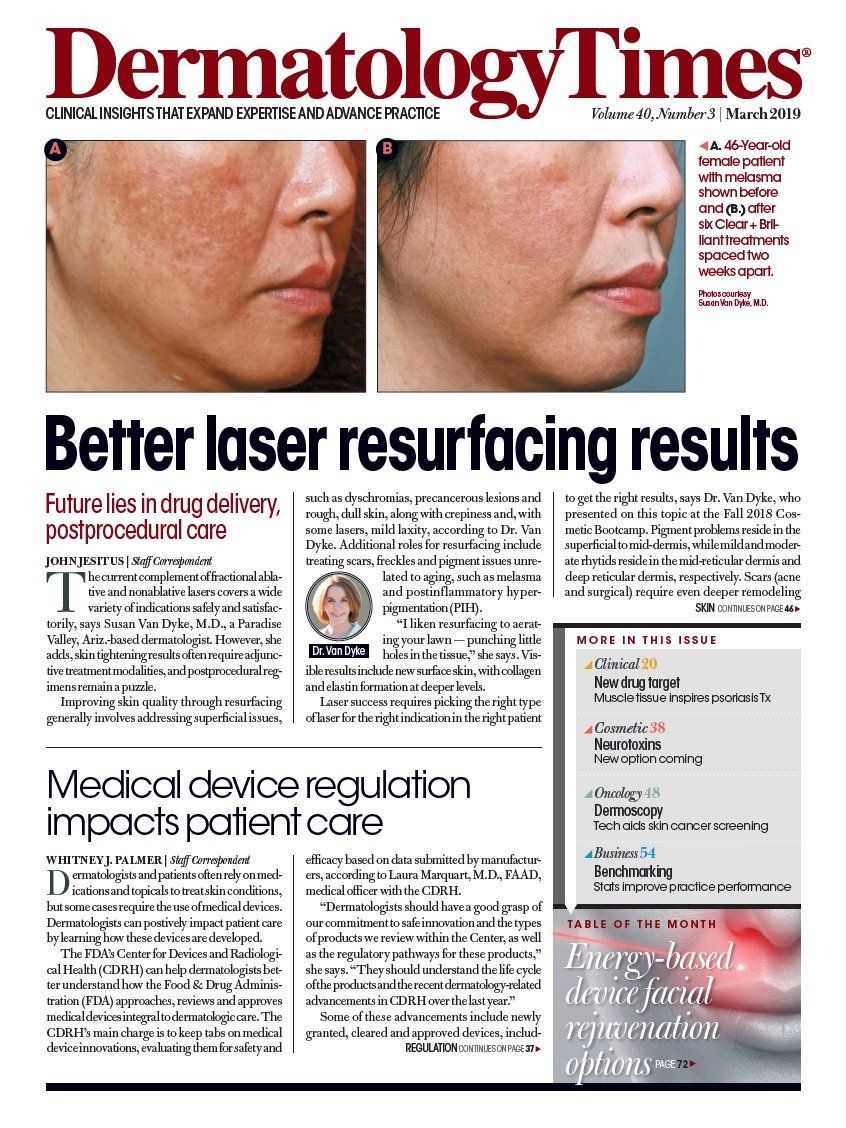- Case-Based Roundtable
- General Dermatology
- Eczema
- Chronic Hand Eczema
- Alopecia
- Aesthetics
- Vitiligo
- COVID-19
- Actinic Keratosis
- Precision Medicine and Biologics
- Rare Disease
- Wound Care
- Rosacea
- Psoriasis
- Psoriatic Arthritis
- Atopic Dermatitis
- Melasma
- NP and PA
- Skin Cancer
- Hidradenitis Suppurativa
- Drug Watch
- Pigmentary Disorders
- Acne
- Pediatric Dermatology
- Practice Management
- Prurigo Nodularis
- Buy-and-Bill
Publication
Article
Dermatology Times
Benchmarking improves financial performance in dermatology
Author(s):
In order for a dermatology practice to advance to the next financial level, it is important to identify needed areas of improvement. This is where benchmarking comes into play.
In order for a dermatology practice to advance to the next financial level, it is important to identify needed areas of improvement. This is where benchmarking comes into play. (janews094 - stock.adobe.com)

In order for a dermatology practice to advance to the next financial level, it is important that you identify needed areas of improvement.
“This is where benchmarking comes into play,” says George Smaistrla Jr., FHFMA, CMPE, CPC, who serves as secretary/treasurer of the board of directors of the Association of Dermatology Administrators and Managers (ADAM) and chair of their benchmarking committee.
“Benchmarking are those sets of statistics that the practice deems relevant regarding its operations which can be used for trending purposes,” he says.
Statistics can range from something as simple as the number of patient visits in a day, week or month, to the amount of charges being generated or the amount of dollars being collected.
“Typically, what a practice will do when it starts to take on a process improvement or tries to maximize its ability to improve its overall operations is select some key statistics or some key metrics to track,” Mr. Smaistrla tells Dermatology Times.
For example, by tracking the number of daily appointments and the number of kept appointments, the practice is able to determine the amount of unused time capacity and consider ways to potentially fill those slots.
“Where are your appointments coming from or where might you better target to increase the volume of appointments?” poses Mr. Smaistrla, an office administrator at Texas Dermatology Specialists in Katy, which evaluates referring doctors. “If we find that these doctors are focused in one area of expertise but not another, then we begin to target the area that we are not getting appointments from.”
Strategies include reaching out to primary doctors to send their patients to the dermatology practice and enhancing patient online searching so the practice shows up at the top of the list.
Practices should also contemplate ways to book more appointments within the same number of hours. For instance, instead of scheduling every appointment for 15 minutes, vary the schedule some with time slots that more closely match the need, like a shortened slot for drug rechecks.
Collecting accounts receivable in a timely fashion can significantly improve overall practice performance as well.
“Revenue cycle management is critical,” says Mr. Smaistrla. “We know that a specific payer like Medicare pays within a very defined time period of not more than 20 days. Thus, for other accounts outstanding over the 20-day mark, we specifically target follow-up to collect those outstanding claims and find out why they are still unpaid.”
In addition, the types of services being provided (products such as sunscreen and moisturizers for skincare; cosmetic services like dermatologic fillers and neurotoxins) can greatly impact the bottom line.
“We look for opportunities to promote one sector more than what is currently popular,” Smaistrla says.
The case mix is also important. For instance, a doctor who routinely bills for a level 3 established patient visit may not be optimizing billing coding for the actual services rendered. “True undercoding is a common occurrence because the doctor may be nervous about being audited,” Smaistrla says. “But you should strive for a more traditional bell curve and make sure the correct code is selected.”
Likewise, a doctor might be choosing a particular service for his convenience rather than what is appropriate for the patient. “A patient with a mole that should be excised may be treated with cryotherapy as opposed to surgical excision to prevent recurrence,” Smaistrla says.
Expense control is also an integral component of a financially healthy practice. How are supplies ordered? How many of the supplies end up in inventory and for how long?
“Perhaps a practice always orders four cases of gloves and/or always has three cases of gloves sitting on the shelves,” Smaistrla says. “This could indicate a supply expense item, whereby your ordering pattern is increasing your expenses when there is really not a need for what you are ordering.”
Similarly, a supply item may be overused without justification. Take Botox, for example, for which six 100 unit vials are billed, yet in reality 10 of those unit vials are actually expended. “In this case, the practice loses 400 units of Botox that were not billed to patients,” Smaistrla says.
Staff compensation and the amount of staff are also vital to ensure elevated financial performance. Tracking the number of hours that staff cover a clinic (10 staff members, each normally working 40 hours a week for a total of 400 weekly hours) might all of a sudden spike to a 150 hours of overtime which is paid at time and a half.
“This probably indicates that you are understaffed and therefore you could save some money by hiring an additional few more employees and reduce some of that overtime expense,” Smaistrla says. “Better yet, look at why you have the overtime in the first place. Does it make sense or not? Perhaps one of your employees are playing with the clock and not giving you real work for the hours being paid.”
One reliable benchmark is the number of full-time equivalent (FTE) staff to FTE providers. “For a busy Mohs surgeon, you might require three FTE staff to one FTE surgeon,” Mr. Smaistrla says. “However, these ratios are all directly dependent on the amount of work being provided by the physician. A new doctor performing fewer cases will not need as high a ratio of staff.”
Employee benefits, though, are not really cost controllable, according to Smaistrla. “You may be able to tweak costs one year to the next, but you are likely only going to achieve a single, one-year saving,” he says.
Finally, Mr. Smaistrla recommends that a practice consistently looks at key metrics and constantly ask what can be done better.
“The only way you can know what you can do better is to know what you have done,” he says.
Disclosure:George Smaistrla Jr. reports no relevant financial disclosures.







